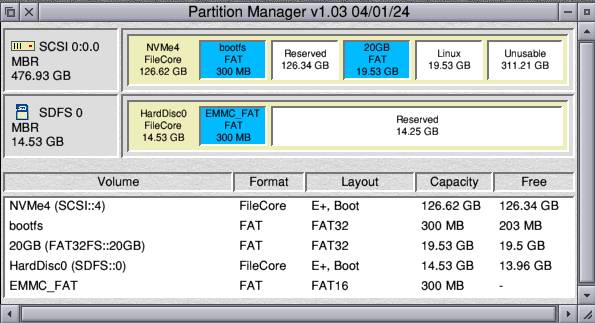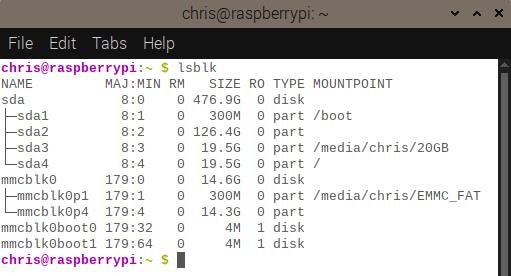Partition Manager
Pages: 1 ... 18 19 20 21 22 23 24 25 26 27 28 29
|
|
I’ve renamed the layout to “E, Risc PC” – its probably used on other machines, so might see another rename before the full release. It’s available here along with a bugfix for ADFS hosted drives. |
|
|
Yuck! I suggest “E, small Ids”. |
|
|
I have tried to create a three-partition drive so that a Linux ext4 partition sits above the standard RISC OS two-partition layout. Partition Manager seems to display it differently to GPartEd, not sure why:
The master boot record is: It doesn’t work by the way, Linux won’t boot from the new partition but can see the files on it! |
|
|
eMail a debug log to me please, so I can see what it did. |
|
|
eMail a debug log to me please PM sent. |
|
|
Version 1.03 of PartMan now shows the rather strange layout I had created (partition 2 followed partition 4) correctly and I have tinkered with the MBR so that the partitons (now totalling four) are in numerical order (as Linux got confused):
The SCSI drive (USB) is a 512GB NVMe drive in a USB caddy (so that RISC OS can see it). The plan is to plug the NVMe drive into the PCIe slot on the Waveshare IO board once RISC OS can handle NVMe drives:
And under Linux it appears as:
|
|
|
One thing puzzles me. If I open the filer window SCSI::NVMe4.$ by right clicking on the SCSI filer icon and then left click on the icon to open a FAT partition on Fat32fs: then select a partition from the menu then the SCSI filer window closes. This close window should be specific to the Fat32fs (before it opens the selected partition) not include SCSIfs. I can always reopen the SCSI window by Filer_OpenDir SCSI::NVMe4.$ but the commands Filer_OpenDir Fat32fs::20GB.$ and Filer_OpenDir Fat32fs::LinuxBoot.$ will only work if that partition is selected and ticked in the menu. Also after left clicking to open a Fat32fs: window (or selecting a partition from the menu), right click no longer works to open the SCSI: window: both left and right clicks open a Fat32fs: filer window. Another thing is that if the drive contains a single FAT partition and nothing else, then the drive can be opened as either SCSI::0 or as Fat32fs::0 but only one of these works correctly, the other fails to show or save data correctly. |
|
|
I can’t say I’ve ever tried to open a drive as both FileCore and MBR based FAT from the Filer at the same time, but at a guess it’s because the drive is directed to a specific filesystem? The usual way to open both, is to open FileCore from the Filer and mount a FAT partition manually. You can do that either via the commandline with FAT32FS, or right-click on a FAT partition in Partition Manager and select to Mount it with FAT32FS. |
|
|
If and when we get an NVMe filer for RISC OS, will PartMan be able to display the partitions on such drives? I can mount an NVMe drive in a USB caddy and see it using PartMan under SCSIfs. |
|
|
Partition Manager communicates directly with drives via ATA/SCSI ops, so drive type shouldn’t matter, provided the host filesystem implements the appropriate SWI. |
|
|
But NVMe will be neither ATA nor SCSI. |
|
|
At protocol level perhaps, but all manor of things are shoe-horned into SCSI on RISC OS as why re-invent the wheel? I’d be surprised if SCSI isn’t used on the RISC OS side, as the alternative would involve a lot more coding to implement. Until a build includes NVMe support, its a somewhat of an academic question. If the RO API is SCSI, it should be supported by Partition Manager; if its a bespoke filesystem, the filesystem just needs adding to Partition Manager. Is anyone actively developing NVMe support? Pi5 / Pinebook Pro both support NVMe at hardware level, there may be others. Do any builds already include NVMe support? It’s not something I actively track. |
|
|
I believe that RO Developments are working on NVME support aimed at the Pinebook Pro. Andrew Rawnsley may well know. |
|
|
I ordered a Pinebook Pro from the Pine store last week, along with a selection of NVMe devices from Amazon so I could look at adding support for building the OS drive into Partition Manager. Andrew is aware, so I’ll follow up on the driver situation when it arrives. |
|
|
Pi5 / Pinebook Pro both support NVMe at hardware level, there may be others. RISC OS Bits was demonstrating an alpha NVMe driver at the MUG Xmas show. The Waveshare Mini IO board has an M.2 NVMe socket on board so supports hardware NVMe over PCIe – with a CM4 I can run Linux with the Linux distro simply dd’d to the drive (I demonstrated this at the MUG Xmas show). I have also created a 4-partition NVMe drive that has FAT/Filecore/FAT/ext4 that works nicely in a USB caddy (i.e. over SCSIfs) – PartMan displays it nicely via USB but at USB speeds of course. Waveshare board and CM4 now in stock at PiHut at quite favourable prices – £32 for the Mini-B IO board and £40 for a 2GB Lite CM4. The NVMe drive was a bit more expensive at £59. I have a PCB that adds RTC and fan controller to a mini-B board (also demonstrated at the MUG show). I also have a mini Desk Pi on order (the PiRO Qube from RISC OS bits is based on this) and that has a M.2 NVMe socket on board. There is also a PCIe board that plugs in to the Pi Foundation IO board that has a M.2 NVMe socket on it offering the same hardware functionality – again I can run Linux on it. I shall be at the SW show with more stuff to demo. |
|
|
Hi Jon, I have previously used !Partmgr to initialise a Pi Boot drive on a 64Gb SD card. Looks like the link being looked for is broken. Does anyone else experience this and any idea how to fix it? Issue was copying lot of stuff to previously created drive with RISC OS, seemed to go slow. |
|
|
Hi Stephen, have exactly the same problem and same error re failed to find packman. I have been trying to enlarge a SDcard image to fill a 32GB card and have been trying both !Partmgr and !Sysdisc (piccolo systems) to achieve the desired outcome unsuccessfully. |
|
|
finally got it to work by copying piboot partition and filecore partition files from another SDcard. Had to rename the drive from Harddisc4 to RiscOSPi. Used a combination of !Sysdisc and !PartMgr with an external USB Card reader and 2 x SD cards (and a bit of trial and error). Do have a working system utilising the full SDcard size, but still cannot initialise the card with !PartMgr due to the error ‘failed to find pacman’. Hopefully will get sorted for next system build. I thought I had wasted my money on !Sysdisc but ended up needing it because of the abovementioned error with !PartMgr. Once this bug is squashed believe !PartMgr will be all that is required – an awesome piece of software for the platform – thanks Jon. |
|
|
The link appears to work correctly and I’ve just built a Pi boot drive without issue. Initialising an SD has to be done via a USB→SD adapter as the Internet stack requires the boot drive to be available – that’s something I can’t workaround. |
|
|
Hi Jon, [Edit] |
|
|
Whilst adding NVMeFS support, I’ve spotted NVMe as shipped from the manufacturer might be using 512e by default, which is not an optimal LBA size for either performance or wear levelling. The NVMe specification recommends a minimum of 4K, so why manufacturers are ignore that and not low-level formatting as 4Kn by default is unknown. There’s a couple of solutions:
The last option doesn’t require much to implement, although I’m not sure if FileCore’s shared objects can accommodate a minimum of 4K or if using a Log2Secsize in the Disc record that’s different to the physical sector size might have a knock-on effect. |
|
|
Whilst adding NVMeFS support, I’ve spotted NVMe as shipped from the manufacturer might be using 512e by default Most NVMe drives are set to emulate 512 byte sectors by default. That is the LBA size is 512B. It is easy to switch them to 4k sectors (if the drive is capable of this) using NVME4kFmt (or nvme-cli tools in Linux) but this destoys all data on disc and the drive then has to be reformatted. Two articles attempt to explain this: |
|
|
My query was more “what should I do about it?” with regard to Partition Manager. Since raising that query though, you and I have discovered DOSFS is hardcoded for 512 byte sectors so I would advise avoiding 4Kn for boot drives on any machine that uses a DOS based Bootloader. PM won’t allow an LFAU smaller than the logical sector size and will try to align to the physical sector size, so LFAU is a non-issue in that regard. Minimum FileCore partition size does become an issue with 4Kn due to the size of the zones, each zone covers 128MB of disk space with an LFAU of 4096, so that’s the minimum partition size that allows zoning. Anything smaller won’t be zoned and will overwrite the partition table – until partition support is added to RISCOS. |
|
|
Partition Manager v1.03 with NVMeFS support is now available for testing. I have to personally thank Chris Hall for all the NVMe testing and RISCOSbits for implementing the various changes to NVMeFS to make this possible. v1.03 of NVMeFS is required, due to various NVMeFS SWI changes that PM relies on. |
|
|
I have to personally thank Chris Hall for all the NVMe testing I quite liked version 19 but version 26 was where it all seemed to work correctly. |
Pages: 1 ... 18 19 20 21 22 23 24 25 26 27 28 29





